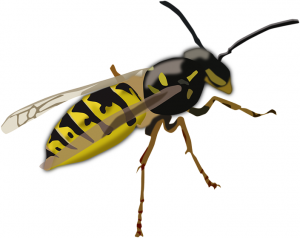
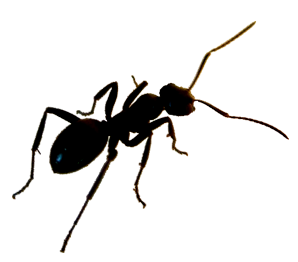
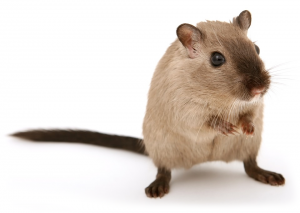
Common Pests Found in Western New York State
Subterranean Termites
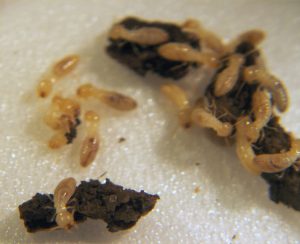 Termites are extremely important in nature because they recycle fallen
trees back into soil. Unfortunately, a termite cannot tell the
difference between a pine log and a pine board. Termites cause more
destruction to wood products and structures in homes than any other
insect. Therefore, homeowners must understand termites and how they can
be controlled.
Termites are extremely important in nature because they recycle fallen
trees back into soil. Unfortunately, a termite cannot tell the
difference between a pine log and a pine board. Termites cause more
destruction to wood products and structures in homes than any other
insect. Therefore, homeowners must understand termites and how they can
be controlled.
The Termite Colony
Termites are social insects that live in highly organized colonies. Like many insects, termites have an egg, an immature, and an adult stage. There are three main types of adults: reproductives, soldiers, and workers. The reproductives include the king and queen and supplementary reproductives that produce eggs. The soldiers protect the colony from attackers such as ants. Workers are the heart of the colony. They clean and care for all the other termites and forage for food (wood and paper products). When a colony is several years old and relatively large, it may produce another form of adult termite called a "swarmer." Swarmers have four wings, are often brown or black, and range in size from approximately 1/4 to 3/8 inch. Swarmers are the colony's way of sending out new kings and queens to start colonies of their own. In the spring, great numbers of swarmers can fly from a single colony. Swarmers are the most visible form of termite. Usually a homeowner realizes termites are present in or around the home when a swarm is seen. Swarming termites can be confused with many ants that swarm in the spring. If you look closely, you can see that swarming ants have elbowed antennae, a narrow waist, and front wings that are longer than the back wings. Swarming termites have straight antennae, a thick waist, and all the wings are the same length. As their name indicates, subterranean termites usually live underground, excavating passageways to reach wood. Their passageways can be quite complex, extending 10 feet underground and over an acre in area. The soil provides a source of moisture that protects the termites from drying and shields them from predators. The soil also provides building materials for the protective shelter tubes the termites use to forage for wood above the ground.Termite Control
The best way to protect your home against termite attack is with a combination of prevention and inspection. Prevention The best control method is protecting your house from attack. For example, if you are building a new house, make sure there will be several inches (at least) between the soil and any lumber. This distance will force the subterranean termites to build shelter tubes, which are about the width of a pencil, from the ground to reach the wood in your house. The tubes make it easier to find and control areas where termites attack. When building, your contractor should remove all roots, stumps, grade stakes, scrap lumber, and other wood debris before your house is completed. After completion, continue to keep wood debris from collecting under or near your house, including piles of firewood. Homes built over a crawl-space should have good ventilation and possibly a vapor barrier to keep moisture levels low. The finished grade on all buildings should slope away from the foundation to keep water from collecting near the house. Proper construction and repair of gutters, roofs, pipes, and other potential sources of water for above-ground termite infestation are very important. You should also ask your contractor about additional building practices he or she plans to use to reduce the chance of termite infestation, such as capping foundation walls and using treated lumber. Chemical control insecticide treatments (termiticides) or termite baits must be used to control established termite colonies. Termiticides should be applied only by a certified pest control applicator. Successful termite treatments require many gallons of diluted soil termiticides applied with specialized equipment. Termiticide application at this level is beyond the ability of most homeowners. Baits that are placed in the soil around the home have shown a lot of promise in recent years. To protect your home, the environment, and yourself, employ a professional pest control company. Remember, your home is probably the most expensive purchase you will make in your lifetime. With a little time and a little knowledge, termite damage can be avoided.Wood Boring Beetles
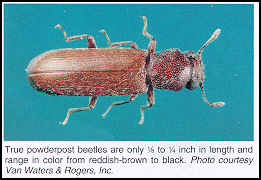 The amount of damage that wood-boring beetles cause depends on many
factors. The type of wood (hardwood or softwood), the moisture of the
wood, and the environmental conditions at the infestation site all
affect the severity of beetle damage.
Only the larvae damage wood. The female lays an average of twenty to
fifty eggs in crevices or on the ends of boards. When they hatch, the
tiny larvae bore down into the wood. As the larvae grow, they bore to a
point just underneath the surface of the wood, there they change into
adults.
After they change, the adults cut a 1/32- to 1/16-inch circular exit
hole in the surface of the wood. Often, powdery wood dust created by the
beetle's feeding is pushed out as the adult beetle emerges. This is why
they are called "powderpost" beetles.
Males and females exit at the same time and mate, and the new generation
of females lay eggs again.
The amount of damage that wood-boring beetles cause depends on many
factors. The type of wood (hardwood or softwood), the moisture of the
wood, and the environmental conditions at the infestation site all
affect the severity of beetle damage.
Only the larvae damage wood. The female lays an average of twenty to
fifty eggs in crevices or on the ends of boards. When they hatch, the
tiny larvae bore down into the wood. As the larvae grow, they bore to a
point just underneath the surface of the wood, there they change into
adults.
After they change, the adults cut a 1/32- to 1/16-inch circular exit
hole in the surface of the wood. Often, powdery wood dust created by the
beetle's feeding is pushed out as the adult beetle emerges. This is why
they are called "powderpost" beetles.
Males and females exit at the same time and mate, and the new generation
of females lay eggs again.
Wood Boring Beetles Control
Borate sprays are the primary treatment for wood boring beetles. Once sprayed onto wood surfaces, the borate is absorbed by the wood. If beetles (or larvae) chew the wood, the borate is injested and they will die. This kind of treatment is also effective against termites and carpenter ants.Carpenter Ants
 (1/4" - 1/2" long) Nesting in damp locations, carpenter ants prefer to
excavate wood that has been damaged by water. From their nests in the
beams, floors or walls, they scavenge the house for food crumbs and
insects. Carpenter ants may occur in several colors, although the most
important species are black.
One of the largest members of the ant family, carpenter ants take their
name from their habit of chewing passageways (called "galleries") inside
wood. They live in these galleries and make excursions, most often at
night, to hunt for food and water. These ants often set up satellite
colonies inside homes from parent colonies located outside in a tree or
landscape timber.
(1/4" - 1/2" long) Nesting in damp locations, carpenter ants prefer to
excavate wood that has been damaged by water. From their nests in the
beams, floors or walls, they scavenge the house for food crumbs and
insects. Carpenter ants may occur in several colors, although the most
important species are black.
One of the largest members of the ant family, carpenter ants take their
name from their habit of chewing passageways (called "galleries") inside
wood. They live in these galleries and make excursions, most often at
night, to hunt for food and water. These ants often set up satellite
colonies inside homes from parent colonies located outside in a tree or
landscape timber.
Where You'll Find Carpenter Ants
Carpenter ants love damp climates and moist areas – damp wood, any dark void, a few morsels of food. Places that get a lot of rain are especially susceptible. So are homes built in heavily wooded areas or in low, shady places where the ground stays damp. In your home, you're likely to find carpenter ants nesting around a sink in the kitchen or bathroom. Maybe even around plumbing leaks, clogged gutters and downspouts. A clean house is no guarantee. When carpenter ants move in, the first thing they do is look for food. Unlike termites, carpenter ants do not eat wood. They search for syrup, honey, jelly, meat, fruit, grease, fat, and other domestic foods. If these favorites are not available in your home, the ants will feed on dead or living insects or any other type of organic matter. To construct their galleries, carpenter ants tear bits of wood and place them outside the nest. These sawdust-looking piles, called frass, may be the first visible sign that carpenter ants are present. Left unchecked for a period of time, these galleries can become quite large. While the primary nest is found in damp wood, carpenter ants establish many satellite colonies. This makes them difficult to control, especially since colonies may be found in any dark void- hollow curtain rods, hollow-core doors, ceilings, dead wall space, etc. Carpenter ants mature in about two months and immediately start enlarging the nest. First year broods are small, with only 10 to 20 workers. But in a few years, when the colony has thousands of workers, small tunnels become major expressways connecting many hidden galleries. You may not be aware that a strong colony is firmly entrenched in your home until it is too late.Telltale Signs of Carpenter Ants
- Trails of workers around the kitchen, pantry, and other areas where food is stored
- Sawdust-like material that workers kick out of their nests during excavation
- Listen for ant sounds in the quiet of the night. When the ants are chewing, or simply moving around in the nest, they make a sound like rustling cellophane.
Pavement Ants
Pavement ants are small ants about 1/8th inch long and dark brown to black in color. They are found throughout the eastern half of the US and are a major pest in the upper Midwest. The name for this ant comes from its habit of nesting under sidewalks and driveways and piling dirt removed from the nest in a mound on top of the pavement. In addition to nesting under sidewalks, pavement ants colonies can be found under other items lying on top of the ground, including stones, logs, boards, bricks and patio blocks. They may nest in open soil close to building foundations or under mulch in landscaped beds. Only rarely do the ants nest indoors in walls, under floors or in insulation. Control of pavement ants should begin with an attempt to locate the nest site. Ants entering buildings from outdoors can be discouraged by sealing as many cracks and gaps in exterior walls as possible. Also, correct poor foundation drainage and repair water leaks.Odorous House Ants
Odorous house ants are small ants about 1/8th inch long and dark brown in color. They are found throughout the US and in spite of their name, are only an occasional pest in the house. Their name comes from the disagreeable odor similar to the smell of rotten coconuts that is given off when the worker ants are crushed. Odorous house ants commonly nest outdoors in the soil under stones, logs, mulch, debris and other items. They will also nest indoors in wall and floor voids, particularly in moist or warm areas. If only a few workers (wingless ants) are observed in the house it is an indication that they are nesting outdoors and entering the house in search of food. If winged swarmers are found indoors, or if workers are consistently seen in great abundance, it likely indicates they are nesting within the house. Control of odorous house ants should begin with an attempt to locate the origin of the ants. Careful and frequent observation may be necessary to develop an opinion about the source. Ants entering from outdoors can be discouraged by sealing as many cracks and gaps in exterior walls as possible.Pharoah Ants
Pharaoh ants are very small in size, and light yellow to red in color with black markings on abdomen. Due to their extremely small size, they can be found in a diversity of places, appearing suddenly. They have a wide range of foraging and their nest are usually well hidden. They are very persistent, with large colonies. Inside they are usually found in the kitchen and bathrooms, but workers are seen trailing along window sills, and baseboards. They can also be spotted near sources of water in the kitchen and bathrooms, counter tops, toilets,drains and sinks. They prefer to nest in recessed areas like wall voids,under some appliance, wall outlets, under carpet for protection, but they can also nest outdoors in lawns and gardens.German
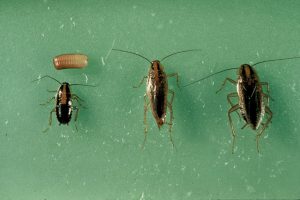 German cockroaches, are the most common roaches found in houses and
restaurants in Western New York State. Most cockroaches have a
flattened, oval shape, spiny legs, and long, filamentous antennae.
Immature stages are smaller, have undeveloped wings and resemble the
adults. They eat food of all kinds and may hitchhike into the house on
egg cartons, soft drink cartons, sacks of potatoes or onions, used
furniture, beer cases, etc.
They can develop into large populations and live throughout the house,
especially in the kitchen and bathroom. During the day, these roaches
may be found hiding clustered behind baseboard molding, in cracks around
cabinets, closets or pantries, and in and under stoves, refrigerators
and dishwashers. When seen during the day in clusters, the population is
large.
Roaches can foul food, damage wallpaper and books, eat glue from
furniture, and produce an unpleasant odor. Some homeowners are allergic
to roaches. The pests can contaminate food with certain bacterial
diseases that result in food poisoning, dysentery, or diarrhea.
German cockroaches, are the most common roaches found in houses and
restaurants in Western New York State. Most cockroaches have a
flattened, oval shape, spiny legs, and long, filamentous antennae.
Immature stages are smaller, have undeveloped wings and resemble the
adults. They eat food of all kinds and may hitchhike into the house on
egg cartons, soft drink cartons, sacks of potatoes or onions, used
furniture, beer cases, etc.
They can develop into large populations and live throughout the house,
especially in the kitchen and bathroom. During the day, these roaches
may be found hiding clustered behind baseboard molding, in cracks around
cabinets, closets or pantries, and in and under stoves, refrigerators
and dishwashers. When seen during the day in clusters, the population is
large.
Roaches can foul food, damage wallpaper and books, eat glue from
furniture, and produce an unpleasant odor. Some homeowners are allergic
to roaches. The pests can contaminate food with certain bacterial
diseases that result in food poisoning, dysentery, or diarrhea.
Wood Roach (Pennsylvania)
Wood cockroaches, also known as wood roaches, are common outdoor dwelling insects native to North America and found throughout Western New York State. Their normal habitat is moist woodland areas but they frequently become a household nuisance because they wander into or are carried into houses as "occasional invaders." They are common in wooded areas of the Finger Lakes, and in woodlots of Monroe County. Wood roaches are very similar in appearance to the common household cockroach called the American roach; flat, oval body, long antennae, spiny legs, chestnut brown color. However, wood roaches are slightly smaller, about 3/4 to 1 1/4 inch long, and the adults, especially the males, appear tan because of the color of their wings. Adults and large nymphs of the wood roach can be recognized by a pale, creamy white or transparent stripe on the outer edge on the thorax. The pale edge extends onto the first 1/3 of the front wings of the adults. Positive identification of small nymphs is more difficult and usually requires microscopic examination. Wood roaches that have wandered into the house usually behave differently than the household roaches. Wood roaches are not secretive; they are active both during the day and at night and they are less likely to scamper out of sight when approached. Also, they will wander about the house without congregating in any particular location.Cluster Flies
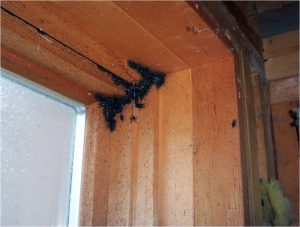 Cluster flies are a nuisance fly invading houses in the fall and showing
up inside on warm, sunny days in winter and spring. A little
biology helps us to understand them better. Cluster Flies spend all
their time feeding and reproducing outdoors. The larval stage is
parasitic to earthworms, their only food source. The adult fly feeds on
flowers. Eggs are laid in cracks of the earth where the larval stage
emerges and attaches to earthworms. Several generations will occur from
May through August.
When evenings begin to cool in late August, Cluster Flies are attracted
to the warm surfaces of buildings and take up shelter for the winter in
wall voids and attics. There they sleep until unusual warmth in Fall and
Winter wakes them. They then become a pest by "clustering" around
windows and lights.
Problems with Cluster Flies are most acute in rural areas where large
open spaces exist. Old farmhouses are particularly prone to Cluster
Flies, though it is due more to the abundance of earthworms and a
"drafty" house than animal waste and farm odors.
The biggest misconceptions about Cluster Flies can be corrected with
understanding their life cycle. Their presence in a home is not due to
unsanitary conditions. It is simply a place of hibernation - much like
the cave to the bear. Keeping them out is better done by sealing
openings than by cleaning up.
Cluster flies are a nuisance fly invading houses in the fall and showing
up inside on warm, sunny days in winter and spring. A little
biology helps us to understand them better. Cluster Flies spend all
their time feeding and reproducing outdoors. The larval stage is
parasitic to earthworms, their only food source. The adult fly feeds on
flowers. Eggs are laid in cracks of the earth where the larval stage
emerges and attaches to earthworms. Several generations will occur from
May through August.
When evenings begin to cool in late August, Cluster Flies are attracted
to the warm surfaces of buildings and take up shelter for the winter in
wall voids and attics. There they sleep until unusual warmth in Fall and
Winter wakes them. They then become a pest by "clustering" around
windows and lights.
Problems with Cluster Flies are most acute in rural areas where large
open spaces exist. Old farmhouses are particularly prone to Cluster
Flies, though it is due more to the abundance of earthworms and a
"drafty" house than animal waste and farm odors.
The biggest misconceptions about Cluster Flies can be corrected with
understanding their life cycle. Their presence in a home is not due to
unsanitary conditions. It is simply a place of hibernation - much like
the cave to the bear. Keeping them out is better done by sealing
openings than by cleaning up. House Mouse
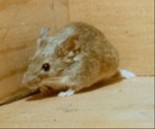 House mice are occasionally found in fields, but usually in buildings.
They will eat most anything and breed year round having as many as a
dozen litters a year of 5-8 young each. Young are able to breed at six
weeks. Because this mouse chooses to live near humans, it is considered a
pest. The House Mouse is a known vector of various diseases,
including Salmonella.
House mice are occasionally found in fields, but usually in buildings.
They will eat most anything and breed year round having as many as a
dozen litters a year of 5-8 young each. Young are able to breed at six
weeks. Because this mouse chooses to live near humans, it is considered a
pest. The House Mouse is a known vector of various diseases,
including Salmonella.
Norway Rat
 The Norway Rat is more at home on the ground, but has been seen crossing
from one building to another along a telephone wire, so it is an
excellent climber. Around poultry houses, the rat feeds extensively on
eggs and young chickens. It has even been known to kill lambs and young
pigs!
The Norway Rat is a source of food for the spotted skunk, barn owl and
house cat, but because the rat is such a prolific breeder, these
predators are often unable to keep the rat population in check.
This rat is known to be a reservoir of bubonic plague, endemic typhus
fever, rat bite fever, and a few other dreaded diseases. Therefore,
buildings and garbage cans should be rat-proofed.
The Norway Rat is more at home on the ground, but has been seen crossing
from one building to another along a telephone wire, so it is an
excellent climber. Around poultry houses, the rat feeds extensively on
eggs and young chickens. It has even been known to kill lambs and young
pigs!
The Norway Rat is a source of food for the spotted skunk, barn owl and
house cat, but because the rat is such a prolific breeder, these
predators are often unable to keep the rat population in check.
This rat is known to be a reservoir of bubonic plague, endemic typhus
fever, rat bite fever, and a few other dreaded diseases. Therefore,
buildings and garbage cans should be rat-proofed. Bedbugs
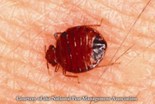 The challenge of ridding a house of Bedbugs is two fold. First, as
Bedbugs can survive without a blood meal for over a year, infestations
can lay dormant. Secondly, traditional pesticides are most
effective as contact killers and not as residual control.
Effective treatments involve the use of many tools, including a thorough
inspection, vacuuming, steam treatments, and materials properly
applied.
How to inspect a hotel room for bedbugs
The challenge of ridding a house of Bedbugs is two fold. First, as
Bedbugs can survive without a blood meal for over a year, infestations
can lay dormant. Secondly, traditional pesticides are most
effective as contact killers and not as residual control.
Effective treatments involve the use of many tools, including a thorough
inspection, vacuuming, steam treatments, and materials properly
applied.
How to inspect a hotel room for bedbugs Deer Ticks
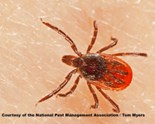 Commonly
called Deer Ticks, their actual name is Black Legged Tick. They have
made it into the news over recent years because they are carriers of
Lyme Disease, a potentially dibilitating infection passed on to humans
through tick bites. Ticks are commonly found in low brush and tall
grasses, and attach themselves to hosts as they pass by. They are
usually picked up by hikers and pets along wooded trails, and low lying
branches. Increased sightings have been found in Monroe County following
the warm winter of 2012.
Commonly
called Deer Ticks, their actual name is Black Legged Tick. They have
made it into the news over recent years because they are carriers of
Lyme Disease, a potentially dibilitating infection passed on to humans
through tick bites. Ticks are commonly found in low brush and tall
grasses, and attach themselves to hosts as they pass by. They are
usually picked up by hikers and pets along wooded trails, and low lying
branches. Increased sightings have been found in Monroe County following
the warm winter of 2012. Bees, Wasps, Hornets
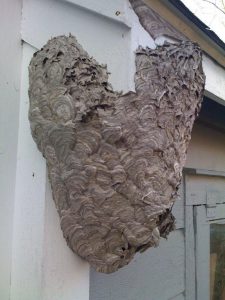 Stinging
insects can be much more than a nuisance - they can be life
and death. Each year news is made from someone hospitalized
from multiple bee stings. Pictured here is a Bald Faced
Hornet's nest. These insects are black and white colored and live
in suspended or hanging nests like this. They are agressive and
easily angered.
Yellow Jackets and Wasps are often missidentified. The open comb
nests often found under eaves of homes, and in vents are Paper
Wasps. These nests are relatively small with less than fifty
insects per colony. Yellow Jackets are usually void nesters
occupying attic spaces, walls, and holes underground. Like the
Hornets they can be very aggressive, especially when alarmed by a lawn
mower or human foot!
Honeybees, Carpenter bees, and Bumble bees are the most common of the
bees in Western New York. They are all pollinators, therefore
beneficial to agriculture. When a Honeybee nest is found, it is
best to contact a bee keeper first to see if the nest can be
relocated. Carpenter bees are well known for the damage they do to
wood trim and overhangs on structures. Bumble bees are often
mistaken with Carpenter bees. Though they look similar, Bumble
bees nest underground, under decks, and in wall voids of buildings.
Of the social bees and wasps, Honeybees are the only ones that maintain
the same nest from year to year. The rest are seasonal nesters.
Stinging
insects can be much more than a nuisance - they can be life
and death. Each year news is made from someone hospitalized
from multiple bee stings. Pictured here is a Bald Faced
Hornet's nest. These insects are black and white colored and live
in suspended or hanging nests like this. They are agressive and
easily angered.
Yellow Jackets and Wasps are often missidentified. The open comb
nests often found under eaves of homes, and in vents are Paper
Wasps. These nests are relatively small with less than fifty
insects per colony. Yellow Jackets are usually void nesters
occupying attic spaces, walls, and holes underground. Like the
Hornets they can be very aggressive, especially when alarmed by a lawn
mower or human foot!
Honeybees, Carpenter bees, and Bumble bees are the most common of the
bees in Western New York. They are all pollinators, therefore
beneficial to agriculture. When a Honeybee nest is found, it is
best to contact a bee keeper first to see if the nest can be
relocated. Carpenter bees are well known for the damage they do to
wood trim and overhangs on structures. Bumble bees are often
mistaken with Carpenter bees. Though they look similar, Bumble
bees nest underground, under decks, and in wall voids of buildings.
Of the social bees and wasps, Honeybees are the only ones that maintain
the same nest from year to year. The rest are seasonal nesters.
Boxelder Bugs
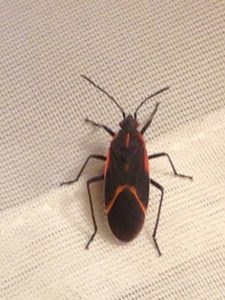 These bugs are harmless from the standpoint of biting, damage to the
house, and food storage. But their prolific numbers on
exterior siding and window frames can be alarming. Boxelder Bugs
tend to be worst on the sunny side of buildings. They can be a
problem throughout the Winter if they find a way in around windows.
These bugs are harmless from the standpoint of biting, damage to the
house, and food storage. But their prolific numbers on
exterior siding and window frames can be alarming. Boxelder Bugs
tend to be worst on the sunny side of buildings. They can be a
problem throughout the Winter if they find a way in around windows.
Stinkbugs (Brown Marmorated)
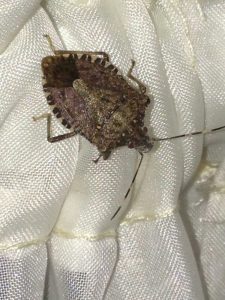 Like many occasional invaders, they are harmless and do not bite.
Large numbers inside can be annoying. If they become an
annual problem, treatments can be done outside in the fall to prevent
their intrusion.
Like many occasional invaders, they are harmless and do not bite.
Large numbers inside can be annoying. If they become an
annual problem, treatments can be done outside in the fall to prevent
their intrusion. Pantry Pests
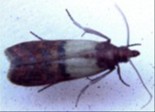 Indian Meal Moth:
The most common of moths found in food products, the indian meal moth
damages food in its larval stage. They are small moths about 3/8"
long, with distinctive dark wing tips. Adult moths are often seen
resting on kitchen ceilings and flying near food products. Best
known for infestations in grains, seeds and nuts, they can also be found
in dried flowers and organic decorations in the home.
Indian Meal Moth:
The most common of moths found in food products, the indian meal moth
damages food in its larval stage. They are small moths about 3/8"
long, with distinctive dark wing tips. Adult moths are often seen
resting on kitchen ceilings and flying near food products. Best
known for infestations in grains, seeds and nuts, they can also be found
in dried flowers and organic decorations in the home. 